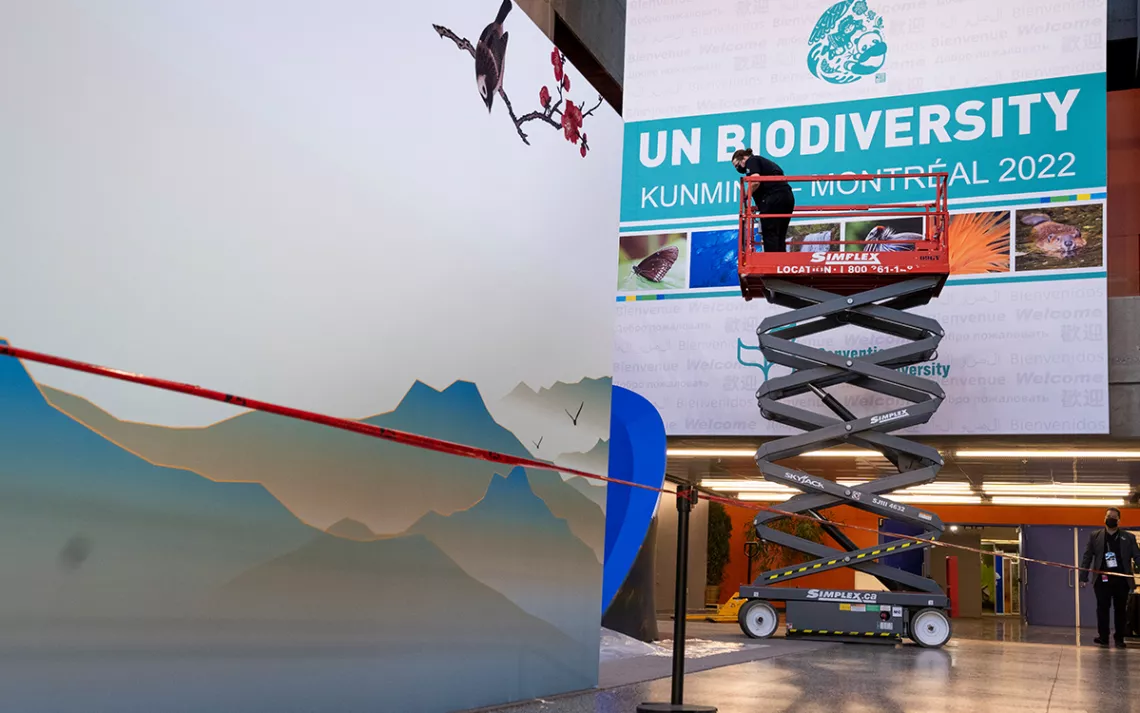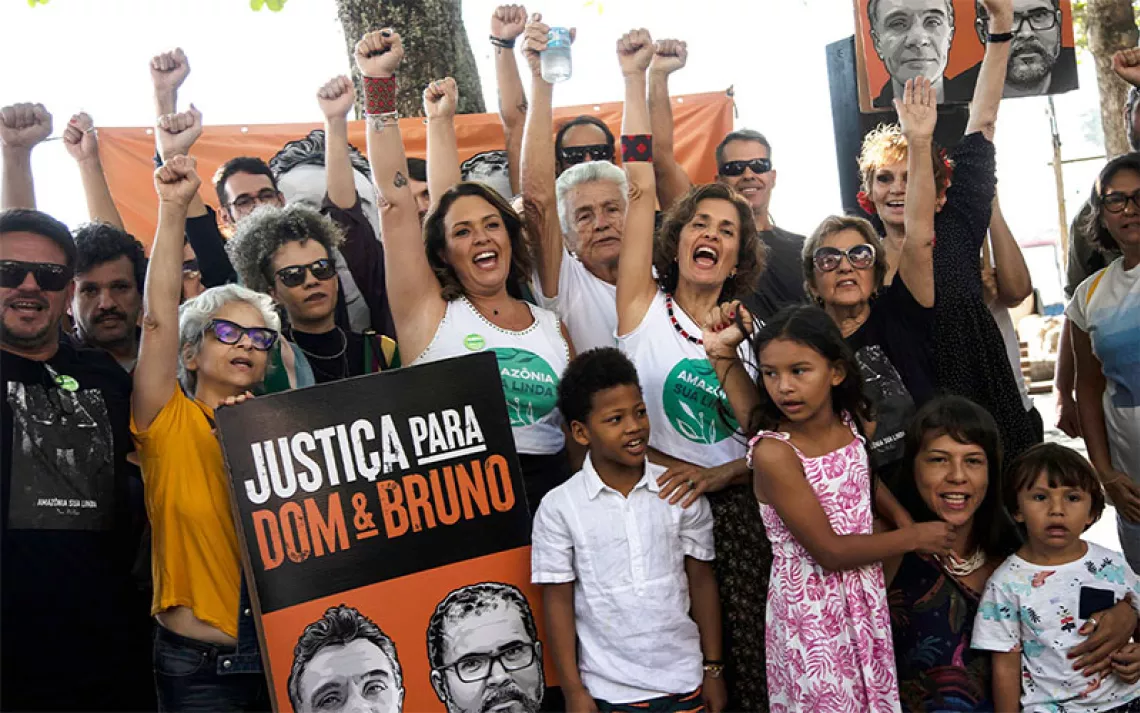4 Things to Watch as the Global Biodiversity Conference Unfolds
These issues could make or break efforts to protect threatened wildlife

Workers set up the Montreal Convention Centre in preparation for the COP15 UN conference on biodiversity in Montreal on December 2. | Photo by Paul Chiasson/The Canadian Press via AP
The world's largest wildlife summit begins today as environmental ministers, corporations, and scientists convene in Montreal to map out a future for life on Earth. The event includes 196 countries, an estimated 10,000 delegates from nonprofit and advocacy groups, and over 190 side exhibits. The goal? To create a new and binding Global Biodiversity Framework that aims to halt the loss of species and ecosystems by 2030 and reverse the degradation of wild nature by 2050.
Two years in the making, the 15th meeting of the Conference of the Parties (COP15) to the Convention on Biological Diversity is an extension of what was supposed to happen in 2020 in Kunming, China. That meeting was canceled several times due to COVID before being revived in two parts—a virtual summit hosted by China last year and this week’s in-person talks in Canada.
By most measures, the previous 2010 framework, also called the Aichi Biodiversity Targets, has failed. None of the targets to prevent the decline of flora and fauna have been fully reached. But for many of those involved in this year’s summit, COP15 feels different.
"Something that is to make this post-2020 global biodiversity framework unique and different from its predecessor is that we're looking at a much more complete series of indicators for monitoring," said David Ainsworth, an information officer at the United Nations Environment Programme. "Those indicators are meant to be created to help link global targets with national activities. Also, these indicators are meant to start measuring data and information right now, not years down the line."
The current working draft includes four overarching goals and 22 targets that negotiators hope will address an assortment of extinction causes, ranging from habitat destruction to exploitation. Some of the most high-profile targets call for protecting 30 percent of lands and waters, halting extinctions, and incorporating Indigenous communities into conservation plans.
Accomplishing each of these targets will be crucial to ensuring that biodiversity loss is stopped by 2030 and reversed by 2050. However, achieving those goals will rest on several issues that could make or break negotiations.
Here are four key things to watch for over the next two weeks.
Heads of state
Perhaps the most startling aspect of the summit is that heads of state were not invited to join. Typically, the presence of heads of state at an international conference conveys to the world that the issues at hand are a high priority in all countries’ interests, said Lina Barrera, the vice president for international policy at Conservation International.
“I think it's definitely a detriment to the process,” said Barrera. “If we don't get a sufficiently ambitious agreement, it will certainly be in part because they weren't here.”
There have been reports that China, the original host country, deliberately excluded world leaders because its delegation wanted to downplay the role of heads of state given that China’s president, Xi Jinping, won’t be attending the conference. However, David Cooper, the deputy executive secretary for the Convention on Biological Diversity, said that this portion of the event was always intended to be at the ministerial level. Instead, he said, heads of state participated in the United Nations Summit on Biodiversity, held in 2020, that was a precursor to COP15. From that event, 64 heads of state crafted a Leaders’ Pledge for Nature that set the stage and tone for what will happen in Montreal.
Most of the environmental ministers, some of whom will have the authority to bind their respective countries to ambitious targets, are expected to participate in a high-level segment toward the end of the conference, where they’ll be able to join the main negotiating sessions and speak with United Nations leaders, like António Guterres, the secretary-general.
However, many groups are calling on heads of state to attend. For example, several British groups recently wrote a letter to Prime Minister Rishi Sunak, urging him to attend. Meanwhile, one notable leader has already committed to attending. Canadian prime minister Justin Trudeau said that he’ll participate in the conference and even spoke at the opening ceremony held on December 6.
The United States is not a party to the Convention on Biological Diversity, which is a frustrating point for some wildlife advocates given the outsized role the country could play in supporting the goals outlined in the draft. A US delegation is expected to attend, with the highest-profile member being Monica Medina, the first assistant secretary of state for oceans and international environmental and scientific affairs. Some wildlife groups are calling on the United States to create a national biodiversity strategy that, while not a part of the UN-backed Global Biodiversity Framework, could contribute significantly to the global targets.
"If we look at what's happened previously, in other processes, then it's usually the ministers that have to roll up their sleeves and help get the agreement across the line,” Cooper said in a press briefing. “If heads of state and government do come, we expect that there will be perhaps some that may come, then they will be accommodated, they will be given space to speak.”
Some of the most high-profile targets call for protecting 30 percent of lands and waters, halting extinctions, and incorporating Indigenous communities into conservation plans.
Monumental scale
The second issue to watch out for is the sheer scale of the aspirations being discussed. There is a reason that it's taken so long to draft a new agreement: It can be tricky to get countries to agree on a single objective. Getting them to agree on 22 will likely be even harder.
Many conservation groups hope to create a clear, concise goal for wildlife protections, something similar to the climate goals established in the 2015 Paris Agreement. But measuring biodiversity well-being is more complicated than evaluating progress on greenhouse gas reductions. Unlike climate change (in which progress can be measured by the global level of heat-trapping gases) biodiversity health is not represented by a single species or ecosystem; rather it’s the interconnectedness of all life on Earth.
To help make the talks as smooth as possible, a series of informal discussions were held leading up to the summit. Those discussions have already been effective to some degree. At the start of the negotiations in 2020, the draft agreement had some 1,800 instances of “bracketed text”—that is, language on which negotiators had not yet agreed. The number of bracketed text sections has since been whittled down to 900.
But there’s still a great deal of language to get through. The most recent draft framework, from this past June, is 45 pages long, has over 20,000 words, and 20 targets that have yet to be agreed on.
“We have observed that reaching consensus on the elements of the post-2020 Global Biodiversity Framework is very difficult, as countries have different environments, and different opinions on how to manage biodiversity and how to move forward in the protection of the environment,” said Alejandra Goyenechea, senior international counsel at Defenders of Wildlife. “Progress has been painfully slow in the targets and goals we’re following closely.”
Financing
Another sticking point for the talks will be financing. To date, very little progress has been made on ways to fund conservation and restoration efforts. By last Monday, none of the financial sections had been agreed to, further complicating the job of the negotiators once the meeting begins.
While no countries have agreed to the text on financing, a cohort of financial institutions have developed a Finance for Biodiversity pledge that over 100 groups, ranging from investment firms like EverHope Capital to nonprofits like the Sierra Club Foundation, have signed on to. Written in 2020, before COP15 was scheduled to start, the pledge serves as a blueprint for negotiators to use as they look for ways to fund global targets.
In a statement put out by the pledge’s organizers, the signers call on countries to mandate that financial firms invest in activities that promote and enhance programs that benefit nature and encourage sustainable land use. It also calls on countries to stop providing subsidies that are harmful to wildlife and natural ecosystems, such as those that incentivize deforestation and other forms of habitat loss. One initiative calls on corporations to disclose the way in which their activities could help or hinder conservation efforts.
“Financing is always the Achilles heel of every global agreement,” said Floran Titze, adviser to international biodiversity policy at the World Wildlife Fund–Germany. “And I think that's also very clear to everyone in the negotiation rooms that we will never be able to agree to an ambitious global biodiversity framework … if there's not enough financing commitments on the table.”
Political will
While the Aichi Targets were a great way to establish the intention of avoiding extinctions and preserving wildlife populations, very few of the countries actually put into place measures that aligned with the global targets. Even the UN agencies responsible for the treaty saw this as the major fault of the framework, as they noted in their progress report.
Close watchers of this year’s summit say the targets in the new draft will need to avoid this pitfall if they are to be successful. But even consensus won’t be enough. The goals and targets need to be proportional to the threat that wildlife and natural ecosystem are under. Justina Ray, the president and senior scientist at the Wildlife Conservation Society of Canada, says that the goals will have to focus on the strength of protections. “It's not enough to have the quantity,” Ray said. “You have to have the quality of protection.”
For instance, conservation groups say the target on the widely known 30X30 goal is toothless without guidance on what constitutes “protected land.”
Here in the United States, President Biden's America the Beautiful plan notably aims to achieve 30x30, but the plan has attracted complaints from some conservationists for its broad definitions of what counts as protected. While most US Forest Service and Bureau of Land Management lands are more or less in a natural state, they are often ineffective at protecting biodiversity, conservation groups say, because those lands allow logging and grazing—two practices that contribute to wildlife habitat degradation. In short, it’s not enough to just protect 30 percent of lands and waters; those lands and waters need to be rich in biodiversity.
To help ensure that the targets are effective, some groups are recommending that specific, ambitious measures be incorporated into the final framework. In addition, government leaders and conservation groups are requesting that each target include timebound review and reporting processes.
“At the beginning of this process a few years ago, parties agreed that weak implementation was a key reason why the previous targets were not agreed,” said Guido Broekhoven, head of policy research and development at the World Wildlife Fund, in a press briefing the day before the summit started. “Essentially what we need to see is fewer words, but more ambition and more urgency.”
 The Magazine of The Sierra Club
The Magazine of The Sierra Club



